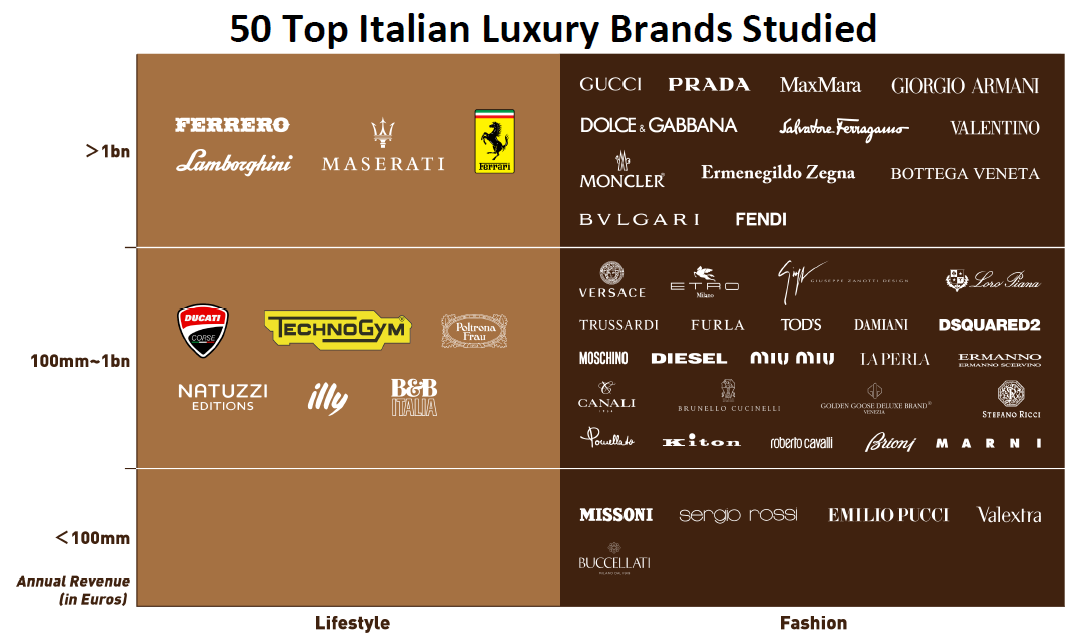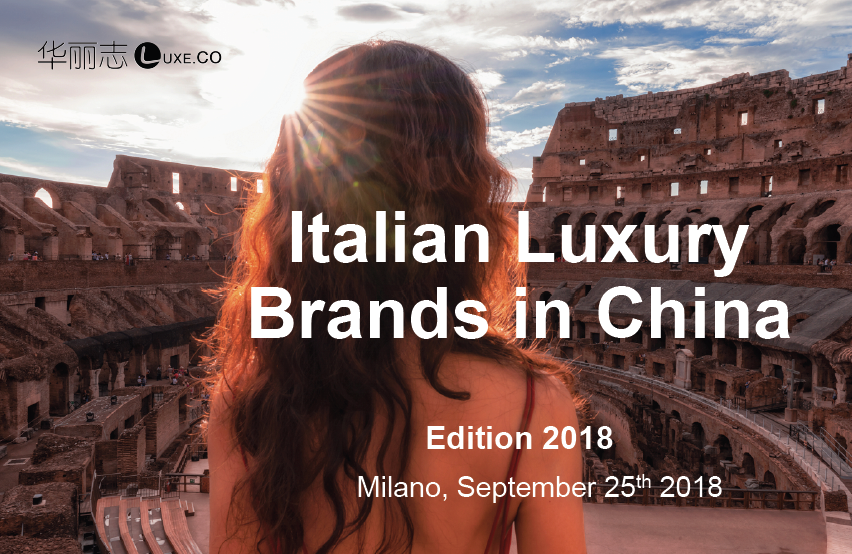Luxe.Co Milan ForumяМ Observation on Italian Luxury Brands in China
September 27,2018
Luxe.Co successfully hosted the тGlobal Fashion Innovation and Investment Forumт in Gerolamo Theatre, Milan on Tuesday 25 September 2018, with the key theme тItalian Luxury Brands and Chinese Fashion Consumersт.
During the forum, Alicia Yu, Founder and CEO of Luxe.Co presented the proprietary report by Luxe.Co "Latest Observation on Italian Luxury Brands in Chinaт.
This is for the first time Luxe.Co tries to focus on luxury brands in a particular country and see how they are performing in China. All the data in the report collected by Luxe.Co are public data. The report not only provides a comprehensive review of the business performance and the growth potential of Italian luxury brands in China, but also unveils interesting facts and data about the latest digital marketing initiatives of leading brands, and their interactions with the new generation of Chinese consumers.
The report covers the following two parts:
- 50 Top Italian Luxury Brands Study
- Luxe.Co Reader Survey
50 Top Italian Luxury Brands Study
50 top Italian luxury brands with direct presence in China are in the following categories: apparel, leather goods, jewelry, cars , furniture& household objects, accessories and food &drinks. The brands are divided into two sections, one is lifestyle, the other is fashion.
In terms of the sales, some of the brands are about тЌ1 billion sales a year. Some of them are between тЌ100 million to тЌ1 billion, which comes to the most. And some of them are below тЌ100 million sales every year.

The selected brands are based on 4 criteria:
- Overall scale business
- If they have presence in China
- Representative
- Availability of Data
тNext year we will expand from top 50- 100, maybe in a few years to top 200. There are so many brands in Italy. Actually we have an editorial team, who are covering Italy news. Every day I see brands Iтve never seen before.т Yu said.
According to data collected by Luxe.Co in many reports, the number of Chinese consumers counts about 30% regardless whether spend in China or outside China.
Online sales is booming, and it grows about 43% a year much faster than offline. But offline is also growing stable. Although there are some peak year and low year like 2016, it is quite flatяМfor 2017, it picked up a little bit. China becomes the fast growing luxury market in the world.
01
China Market
It is very interesting that 38 of the 50 Italian brands have got Chinese website. And 25 of them counted China as their top market. 39 of them open their mono-brand stores in China, and they all probably know in China we donтt have much support whole sale business like elsewhere in the world. When they go to China, all the companies need to open their own mono-brand store. Thatтs a big challenge for them.
Lots of brand, Zegna came to China as early as at 1991, Armani a little bit later 1998, Ferragamo 1994, Prada 1995. They are the early comers at China market.
At the beginning, for most of the brands the only place they can open a store is inside a five-star hotel. And all of them were in Beijing or Shanghai at that time. And gradually, some high end department stores are setting up, then they built more and more shops.
And lately, many of these big brands are renovating and open flagship stores, and most of them are toward street, although still inside the shopping malls or department stores.
Ferragamo, Zegna, Gucci, Versace, Moschino, these brands all have the biggest number of the stores. Not all of them are opened directly by the parent company. Some are opened by the Chinese partners.
02
Channel
For all these 40 fashion brand presented in China, the mean of the number of the stores are 25, the medium is 21. The top 20 Italian brands have bigger number storesяМsay ,the mean number is 42 and the medium is 38.
A lot of the brands Luxe.Co surveyed are quite active in China market. Either they have their own official websites setting directly to China consumers, or they have opened the WechatяМхОЎфПЁяМ official account. And the fancy little things is called Mini Program(хАчЈхК). Itтs like an app inside the app, where brands can sell things or have some digital interactions with your costumers. 19-20 of them are using this kind of features. And in 2 Chinese major commerce websites T-mall яМхЄЉчЋяМand JD.comяМфКЌфИяМ, 11 and 18 of them have opened their stores. Since then they have much bigger presence on China e-commerce platform.
Wechat is now China No.1 social media platform. Itтs not just a social media app, itтs really an all-in-one. You do everything there, you chat, send documents, buy stuffs, read articles and interact with your favorite celebrities. So we just take Wechat as a sample, see 46 brands have their official Wechat account. And 21 of the 50 are opening shopping functions on Wechat. Itтs quite tricky that someone open the function it works, because if they have a large fan base on Wechat, and they can interact with fans with your shopping function inside the Wechat, and to make the purchase. But if brands are still building up your audiences, this kind of function maybe just the backup. Still everything is about the fan base, how big the fan base is.
03
Social Media
For all brands social media is the thing you cannot ignore. According to a Luxe.Co's previous survey with 1700 respondents, 53% of them said Wechat is indeed the No.1 channel for consumers to get information.
Many brands have Wechat accounts, but not everyone is active. The report analyzes the average number of reads per article since account inception and the number of 2018 average read per article by the brand. Gucci as an example, maybe Gucciтs Wechat account is there for 4 or 5 years. But it hasnтt been very active until this year. Compared with French brand Louis Vuitton and Chanel, Gucci is enjoy the social media heat. Other brands actually have their own presence, but some is not very active. If you have presence in the social media, but you donтt actually manage it, itтs not quiet meaningful.
Weibo(хОЎх) is the second important social media in China for brands. Itтs more reflecting the presence or the popularity of the brands in China. Even some relatively small brand in terms of sales can join the social media platform.
Although 46 brands in the 50 have official Weibo account, but actually 21 of them are really active. That means they donтt publish content every day. Although China has such a big population and very important, if you compare the population with the number of followers in Weibo. The later one is relatively small, and it is much smaller than the share of Chinese consumers purchase. A lot of brands on social media present more and more for western audience. They need to put on more effort on Chinese audience. By comparison, Instagram is relatively good place to show pictures with lots of noise. But Weibo is full of shows, stars, and lots of people interacting, following and having fun. Itтs not a very serious place for brands to show themselves. This is the fact in China, brands have to find a right strategy around that.
Magazines comes after Wechat, Weibo and Instagram. A few of people in China subscribe magazines on regular bases. Everybody using their mobile phone, damaging the magazine sales. But luckily still a lot of fashion people they read magazines, as important as Wechat, Weibo and Instagram.
One last thing is official websiteяМand counted No.5 position. Lots of brands are investing in their websites to educate costumers, to give people the whole image of the brand.
04
Celebrity
Luxury brands can never live without celebrities, although we always have a doubt how useful they are.
It's known that in China the age group of consumers for luxury is much younger than the European countries or even America. According to Luxe.Co's survey on the age group of selective brands' ambassadors, only two selective ambassadors' age are over 40, but another two selective ambassadors are even between age 10 and 20. The largest group of ambassadors is age between age 30 and 40. They are relatively mature with very stable image, also they can influence someone older, also younger than them. Also the age between 20 to 30 is quiet substantial as well.
Comparing the age group of selective ambassadors for the past 10 years. Take Gucci as the example, in 2008 they selected very top actor Xiaoming HuangяМщЛццяМ when his age was 31. Now in 2017, Gucci selected Ni NiяМхЊхІЎяМ, whose age is 29. It's relatively stable. But Armani tends to choose more younger faces from 2008 to 2017.
Since everybody think about the large population China has, some brands are choosing ambassadors from the celebrities who have fans beyond 40 million. In fact, itтs really difficult to select the right celebrity ambassador, because they are looking for the people whose fan base is over 40 million. There are only handful of them, not more than 15. A lot of them are not suitable for the brand. Also some of them donтt like the brand.
Brands are making efforts. Bottega Veneta chose 18 years old Jakson Yee яМцчхчКяМ to be their ambassador. Since they announced this new ambassador, it witnessed the brand's Wechat search and baidu search are shooting up.
It's doubting whether this kind of young ambassador will do good for the brand in the long term or not. But at least for now, they do help the brand in social media.
Luxe.Co Reader Survey
Luxe.Co published a quick digital survey on Italian luxury brands with 729 respondents with very serious attitude before the Milan forum. The survey is to listen to Luxe.Co's readers' thoughts about how they think about the Italian brands.
75% of the readers are below 35 years old and 75% of them are iPhone users.
Those who use iPhone generally represent the top 20% of Chinese consumers. Luxe.Co is very confident that the readership is the high end consumers.
Q1: In which country do you consider the best in luxury?
60% of the readers' answer is Italy, and the gap between Italy and UK, Switzerland is bigger than we thought.
Q2: In which category is "Made in Italy" considered superior to other country?
"bags","shoes"and"cars". In China, the luxury purchase has not yet enter into the field of furniture, jewelry or even food. People are yet to upgrade their spending in those categories.
Q3: What attributes are associated with products made in Italy?
Around 80% of the readers selected craftsmanship. They think craftsmanship is the most important when they talk about the products.
Then history is 60%.Close to 50% of them chose art followed by the high quality material and the design. The status symbol is the least important.
Q4: Which brand do you prefer and are most likely to recommend to your friends?
Gucci is the number one, because itтs so hot. It has such a big social media boom. Valentino is the number one respondents want to recommend to their friends. All the others are heritage brands rather than niche brands. Although Loro Piana only opened a few stores in China, people think they have the best cashmere.
To get a PDF version of the full report, please contact us at account@hualizhi.com with your company name, job title, industry and the purpose of asking for the report.













Comments